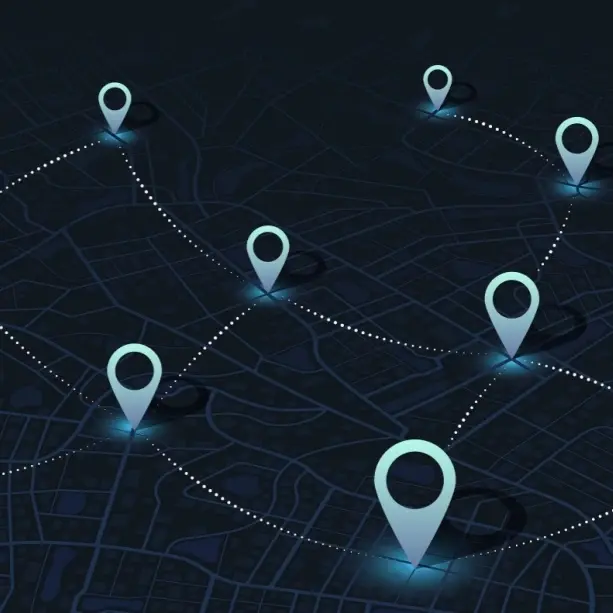In recent years, there has been a trend in the logistics industry of fleet managers integrating technology into daily operations in hopes of improving their supply chain management strategy by unlocking new efficiencies. The two most commonly implemented technological sources are AI and fleet tracking. Since both options are common supply chain management solutions, managers are often left to wonder which one they should choose when they invest in a supply chain management system. If you’ve ever been plagued by this question, you’ve come to the right place. We’re going to break down these two options by their pros and cons and provide you with a recommendation based on your unique situation.
Increase Your ROI by Investing in AirFinder Everywhere
- Loss Prevention. Reduce the amount of loss that occurs during the supply chain process
- Location Coverage. AirFinder Everywhere uses a combination of GPS, Cellular, and WiFi to determine location everywhere
- Security Alerts. Know when a delay in shipment has occurred so the problem
can be addressed immediately.
What is Supply Chain Management?
Supply chain management is a general term to describe the management of supply chain activities, ranging from warehousing and storage to distribution and transportation and everything in between. Managing a supply chain is an important part of logistics operations. If done inadequately, the supply chain might experience delays and other problems that damage the customer’s experience. A robust supply chain management strategy often includes the integration and optimization of key business processes, including demand planning, inventory management, order fulfillment, and logistics, to create a seamless and responsive supply network. The complexity of modern supply chains, often spanning multiple countries and involving numerous entities, necessitates a high level of coordination and adaptability between these process stages in order to respond to market dynamics, disruptions, and changing consumer demands effectively. Through supply chain risk management, improving agility, and leveraging innovations such as AI and fleet tracking, companies can build resilient and competitive supply chains that drastically improve their daily operations.
Why Use Technology To Improve Supply Chain Management?
Using supply chain management software enables companies to collect and analyze key data points that can be used to optimize supply chain operations. By leveraging advanced analytics, companies can gain deeper insights into historical sales patterns, allowing for more precise demand planning. This reduces the risk of overproduction or underproduction, ensuring that inventory levels are aligned with actual market demand, thus minimizing waste and reducing carrying costs. Furthermore, optimized production schedules facilitated by technology ensure that resources are allocated efficiently. Advanced planning systems can adjust production timelines based on real-time data, such as changes in raw material availability or shifts in customer orders. This flexibility helps manufacturers respond swiftly to market changes, enhancing their ability to meet customer expectations and maintain a competitive edge. In addition to demand forecasting and production optimization, technology plays a critical role in identifying and mitigating potential bottlenecks within the supply chain. By continuously monitoring the flow of goods and materials, supply chain management software can detect disruptions or delays early on. Moreover, the use of predictive analytics and machine learning algorithms can further enhance supply chain resilience. These technologies can simulate various scenarios, such as sudden spikes in demand or supply chain disruptions due to unforeseen events, and recommend optimal strategies to manage these situations. This proactive approach helps companies build more resilient supply chains that can adapt to uncertainties and maintain operational continuity.
AI vs. Fleet Tracking: Comparing Solutions
Fleet Tracking in Supply Chain Management
A fleet tracking system provides many benefits for fleet managers, with the most important being supply chain tracking. A fleet tracker provides real-time visibility of assets throughout the supply chain, including pallets, cargo, and the trailers themselves. While fleets are already equipped with telematics systems for their trucks, this solution expands on the provided visibility by extending it to the non-powered assets that telematics are not designed to detect, including when the truck is powered off. Fleet tracking also provides more granular visibility than telematics when it comes to a trailer’s contents. This is important because it’s easy for a pallet to get loaded onto the wrong trailer in the midst of a busy day, and it’s incredibly difficult to catch this mistake without visibility of what’s going on inside a trailer. A fleet tracker helps in this area. While fleet tracking solutions do not and are not designed to replace telematics systems, combining the two solutions provides complete visibility of logistics operations in a way that telematics cannot on its own.
AI in Supply Chain Management
AI is revolutionizing logistics and supply chain management by introducing advanced capabilities that enhance decision-making to increase efficiency and resilience. One of the most significant contributions of AI in automated supply chain management is its ability to process and analyze vast amounts of data to identify patterns quickly and accurately. This capability is particularly useful for demand forecasting, where AI can analyze historical data to predict future demand with high accuracy. Having improved demand forecasting helps companies maintain optimal inventory levels, reduce costs associated with overstocking or stockouts, and enhance customer satisfaction by ensuring product availability. Route optimization algorithms can also be used to analyze delivery schedules to determine the most efficient routes for transportation. This reduces fuel consumption, lowers transportation costs, and ensures timely deliveries. Additionally, AI-powered predictive maintenance systems can monitor the health of transportation vehicles and warehouse machinery, predicting potential failures before they occur. By scheduling maintenance proactively, companies can avoid costly downtime and ensure smooth operations.
Combining Fleet Tracking and AI
Fleet tracking and AI together offer a powerful combination to enhance supply chain operations management by providing real-time insights, predictive capabilities, and operational efficiencies. Fleet tracking involves the tracking and monitoring of the location, movement, and status of trailers and other assets in a transportation network. When integrated with AI, these systems can analyze vast amounts of data to optimize routes and enhance fleet performance.
One of the primary benefits of integrating fleet tracking with AI is the optimization of delivery routes. AI algorithms can analyze the historical route data provided by the system to determine the most efficient paths for vehicles. This not only reduces fuel consumption and transportation costs but also ensures timely deliveries, improving customer satisfaction. By continuously learning from the ongoing fleet tracking data stream, AI systems can adapt to changing conditions such as road closures or traffic congestion in real time to provide dynamic route adjustments to drivers.
Predictive maintenance is another significant advantage of combining fleet tracking with AI. Asset tracking systems collect data on trailer usage. AI can analyze this data to predict potential mechanical issues before they lead to breakdowns or identify trailers that are scheduled for maintenance that don’t actually need it. By identifying patterns and anomalies, AI can schedule maintenance proactively, minimizing downtime and preventing costly disruptions in the supply chain. This approach both extends the lifespan of the fleet and ensures a higher level of operational reliability.
AI-enhanced fleet tracking also improves safety and compliance within the supply chain. AI can help ensure compliance with regulations by tracking hours of service and other legal requirements, preventing violations and associated fines. An asset tracking system also has the ability to monitor environmental conditions like temperature. This helps to prevent spoilage and waste.
Furthermore, the integration of AI with fleet tracking fosters better communication and coordination across the supply chain. Real-time data sharing and analysis enable all stakeholders, including suppliers, manufacturers, and customers, to have a clear view of the transportation process. This transparency enhances collaboration, allows for more accurate planning, and facilitates quicker responses to any issues that arise, such as delays or inventory shortages.
The synergy between fleet tracking and AI significantly enhances supply chain management by optimizing routes, enabling predictive maintenance, improving safety and compliance, and fostering better communication and coordination. By leveraging these technologies, companies can achieve greater efficiency, cost savings, and resilience in their supply chain operations, ultimately driving better business outcomes and customer satisfaction.
What Should You Choose?
Our fleet tracking system is a robust solution for tracking and monitoring trailers and other logistics assets, leveraging advanced technology to enhance efficiency and transparency in supply chain operations. Utilizing a combination of GPS, cellular, and WiFi sniffing, AirFinder Everywhere provides real-time location tracking for your trailers and other logistics assets. One of the standout features of our system is its AI integration capabilities, which enables the AI solution to use the data to make decisions for supply chain optimization. This end-to-end fleet management solution not only streamlines operations but also enhances the reliability and sustainability of supply chain activities, ultimately leading to cost savings and improved customer satisfaction.
Integrating technology into supply chain management has become essential for fleet managers aiming to enhance efficiency and resilience. As fleet managers seek to optimize their operations, both AI and fleet tracking have emerged as pivotal solutions. The decision to invest in either technology—or ideally, a combination of both—depends on the specific needs and goals of your company. While AI excels in data analysis and demand forecasting, fleet tracking offers unparalleled real-time visibility and asset monitoring that provides data to AI. AI provides strategic insights and automation that drive smarter decision-making, while fleet tracking provides real-time visibility of assets throughout the supply chain and data for AI to use for smart decision-making. By leveraging these technologies together, companies can achieve a synergistic effect, leading to optimized routes, reduced costs, improved safety, and enhanced customer satisfaction. Ultimately, the integration of AI and fleet tracking together represents a comprehensive approach to building a more efficient, transparent, and resilient supply chain, positioning companies for long-term success in an increasingly competitive market. Book a demo with our team of experts to learn more about our fleet tracking system.

Publisher: Source link











